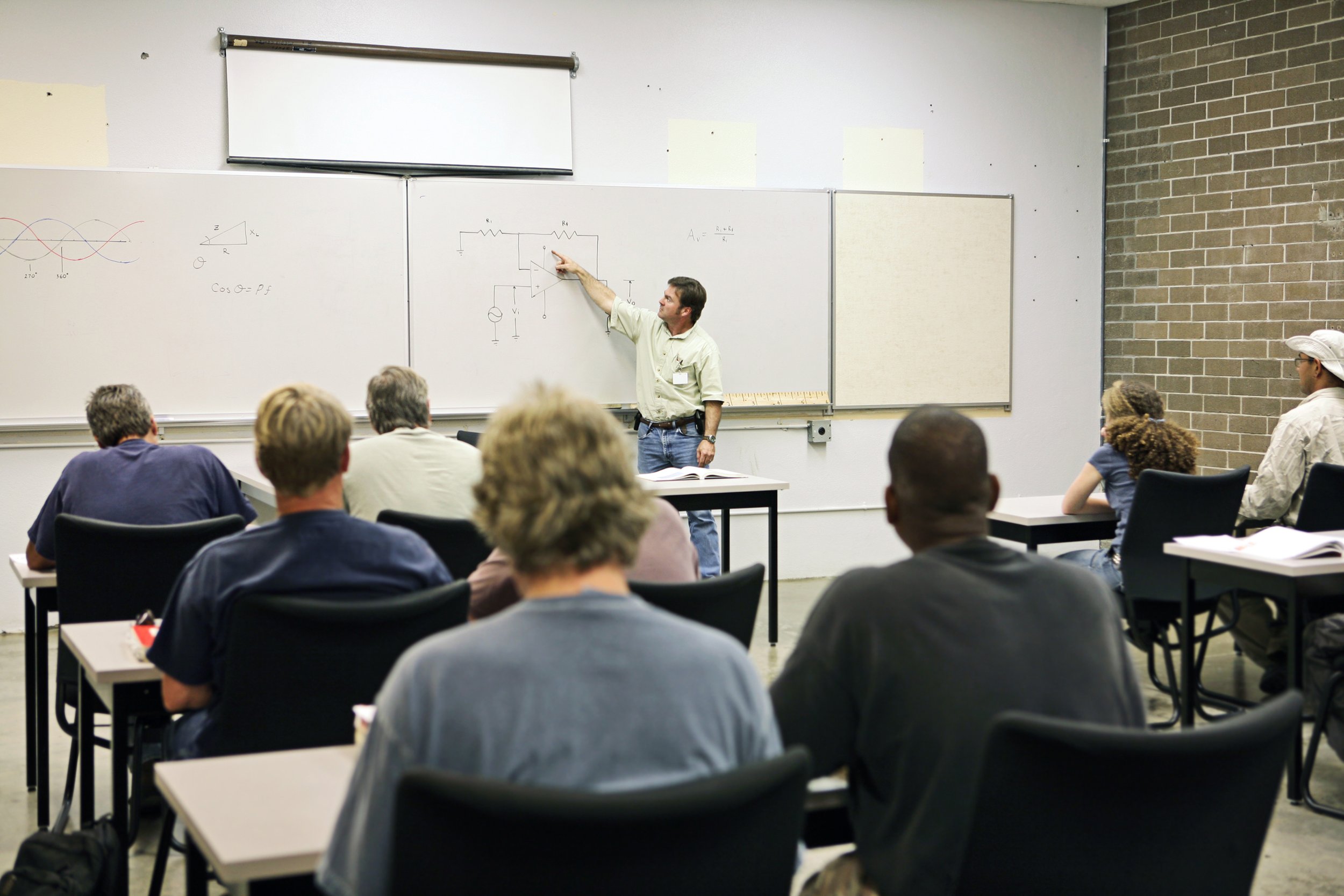
Noncredit Education
Millions of community and technical college students enroll in the “hidden college” of noncredit occupational and basic skills programs every year. Is noncredit a launchpad to employment, an onramp to credit programs, or a dead end for students’ aspirations?
Labor Market Returns to Community College Noncredit Occupational Education
2023
Peter Riley Bahr and Rooney Columbus
Ed Policy Research Working Paper 23-1
https://bit.ly/noncredit_returns
Millions of students enroll in community colleges noncredit programs every year—most in occupational training—but there are few large-scale studies of their effectiveness in increasing students’ employment opportunities and earnings. In this study, we applied individual fixed effects models to state longitudinal administrative data from Texas to estimate the labor market returns to community college noncredit occupational education. We find a modest but statistically significant increase in average quarterly earnings exceeding $500 per quarter (2019 dollars). Returns vary by duration of training, field of study, and number of training spells. Our findings speak to ongoing national policy debates about the expansion of Pell Grant eligibility to include some community college noncredit programs, as well as numerous state efforts to increase workforce readiness.
Topics: Noncredit Education; Education, Employment, and Earnings; Career and Technical Education; Upskilling and Reskilling
What are the Most Common Enrollment Patterns in Noncredit Education and Credit Education? Evidence from Iowa and California Community Colleges
2024
Peter Riley Bahr, Cody Christensen, Rooney Columbus, Jennifer May-Trifiletti, and Jackson Yan
Center for the Study of Higher and Postsecondary Education, University of Michigan
We use administrative data on millions of noncredit and credit students in Iowa and California community colleges to examine the most common enrollment patterns among community college entrants, students who first enrolled exclusively in noncredit education, and students who first enrolled in noncredit education and then later enrolled in credit coursework.
Topics: Noncredit Education
Who Transitions from Noncredit Education to Credit Education? Evidence from Iowa and California Community Colleges
2023
Peter Riley Bahr, Cody Christensen, Rooney Columbus, Jennifer May-Trifiletti, and Jackson Yan
Center for the Study of Higher and Postsecondary Education, University of Michigan
We use administrative data on hundreds of thousands of noncredit and credit students in Iowa and California community colleges to examine the demographic characteristics of those who first enroll in noncredit or credit education as well as those who transition from noncredit to credit education and those who do not.
Topics: Noncredit Education
Community College Noncredit Education in Texas
2023
Peter Riley Bahr, Rooney Columbus, Samuel Kaser, Jennifer May-Trifiletti, Cody Christensen, and Kennan Cepa
Center for the Study of Higher and Postsecondary Education, University of Michigan
We leverage administrative data on over 1.6 million students who initially enrolled in noncredit or for-credit programs at Texas community colleges between academic years 2013-14 and 2017-18. We address the following research questions: who enrolls in noncredit education in Texas? How are noncredit enrollees different from for-credit students? What types of courses do noncredit students take? What kinds of enrollment behaviors and academic outcomes do noncredit students experience? Do noncredit students later participate in for-credit programs of study?
Topics: Noncredit Education; Career and Technical Education
The State Community College Noncredit Data Infrastructure: Lessons from Iowa, Louisiana, and Virginia
2023
Mark D’Amico, Michelle Van Noy, Anjali Srivastava, Peter Riley Bahr, and Di Xu
Education and Employment Research Center, Rutgers
This report follows a series of state-level reports on Iowa, Louisiana, and Virginia that explored the noncredit data infrastructure and presented descriptive analyses of data at the course/program level for each individual state. The findings presented in each of these reports, including the current report that synthesizes results across the three states, were derived through a collaborative approach involving leaders from all three partner states. Research team members worked closely with state leaders to identify data elements pertaining to community college noncredit offerings at the course/program level, which is our unit of analysis for this project, captured at the state level. Further, the research team gathered information on the policy context for noncredit offerings, including state-level data collection that frame what data are available and why. By examining the data elements on noncredit education available in each state, the research team compared these findings both to develop a set of common operational definitions and data inventory as well as to better understand the similarities and differences in noncredit programming and data availability.
Topics: Noncredit Education
Louisiana Noncredit Data Snapshot
2023
Peter Riley Bahr, Amy Cable, Mark D’Amico, and Michelle Van Noy
Education and Employment Research Center, Rutgers
https://noncreditresearch.org/our-work/publications/reports/louisiana-noncredit-data-snapshot/
Today, more than two-thirds of US adults considering further education report that they prefer a non-degree option—up from about one-half prior to the pandemic. With growing interest and investment in opportunities for short-term flexible options to prepare individuals for the workforce, it is essential to cultivate a better understanding of noncredit education and non-degree credentials.
Despite the importance of this information, however, multiple analyses have shown that only about three-quarters of states collect data on their noncredit programming. Furthermore, state-level data collection on non-degree credentials (such as certificates, certifications, licensure, badges, and microcredentials) varies widely and is still under development in many locations. Because data on noncredit education are limited and vary across states, direct comparisons are difficult. This lack of rich and consistent data prevents a comprehensive understanding of noncredit education and results in inconsistent definitions, limited outcomes data, and overall data quality issues.
This report on the noncredit education in the Louisiana Community and Technical College System (LCTCS) is one in a series that explore the noncredit data infrastructure of U.S. states and present descriptive analyses of those data at the course/program level. The findings presented in these reports were reached using a multiphased collaborative approach with leaders in partner states. First, we developed a robust inventory of each of the data elements available at the state level, informed by cross-state meetings and interviews with individual state partners. We then categorized each of the individual data elements and developed operational definitions for each one. Finally, we built state-level data sets consistent with the available data and analyzed these data descriptively.
Topics: Noncredit Education
Investigating the Hidden College: A Study of Community College Noncredit Education in Five States
2022
Peter Riley Bahr, Rooney Columbus, Kennan Cepa, Jennifer May-Trifiletti, and Samuel Kaser
Center for the Study of Higher and Postsecondary Education, University of Michigan
Community college noncredit education is a substantial yet sorely understudied segment of American higher education, enrolling millions of students each year, many in occupational courses. There is growing interest in understanding the extent to which noncredit programs support students’ future educational attainment and workforce preparation, but data limitations at the state and national levels have inhibited intensive research. In this study, we present the most exhaustive empirical portrait of community college noncredit education to date. Using administrative data on millions of community college students from Iowa, California, Texas, Louisiana, and Indiana, we investigate who enrolls in noncredit education, the types of courses they take, and the academic and employment outcomes they experience. Our results both support and temper growing enthusiasm about the contributions of noncredit education to students’ academic and employment goals. Our study offers new and timely insights into community college noncredit education, addressing pressing policy questions regarding articulation between noncredit and for-credit education, the labor market value of noncredit education, and the collection of data on noncredit education.
Topics: Noncredit Education







